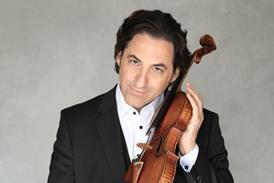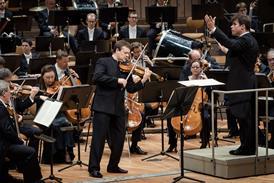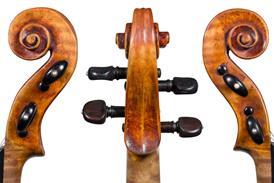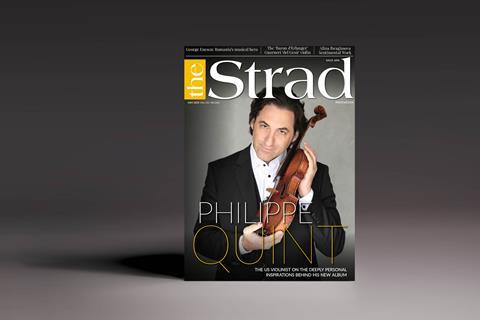Teaching adults need not be a daunting prospect. For Alice McVeigh the rewards outweigh the problems, as she reveals in her guide for tutors. From 2014

Explore more Featured Stories like this in The Strad Playing Hub
This article appeared in The Strad August 2014 issue
Many years ago, having finished music college, I agreed to fill in as interim cello teacher at a girls’ boarding school in Sevenoaks. I was granted an interview with the head teacher, a Maggie Thatcher lookalike, who informed me, in cut-glass tones, that I was hired as long as I refrained from ‘such appalling Americanisms as blue jeans and chewing gum’. So intimidating did I find her that I agreed to so refrain without daring to observe that gum-chewing is not a sin to which I had ever been addicted, or that peer-reviewed research has yet to establish any link between the wearing of jeans and rotten cello teaching.
The school proved to be my introduction to cello teaching, and a pretty steep learning curve it was. There was little Lottie (not her real name), whose innovative notion of a down bow was a strokestarting near her left earlobe and ending curled up somewhere around her right. There was Susanna, scion of a famous literary family, who disdained second and third position, preferring (with a perseverance worthy of a better cause) to play (at speed) D–E–D–E on the A string with the profoundly original fingering 4–1–4–1. And there was Joy, who confided to me her determination to run away from school, and who was, I flattered myself, my one success of the term. (Managed to talk her out of it; don’t know why; giving the matter impartial consideration now I think I’d have run away, too.) Not to mention the freezing hut where the instrumental teachers were regularly cast into outer darkness, nor the weekly machinations necessary in order to swipe little Sophie from the clutches of her rapacious French teacher and into her cello lesson.
Perhaps the school prejudiced me unreasonably against the joys of teaching children. All I can say is that (after my daughter’s birth) when I again considered taking up my teaching cross and walking, I found that the option of teaching kids held curiously little appeal. Instead I bunged the following ad in my local paper: ‘Professional cellist seeks adult pupils of any standard. Must be keen as mustard.’
However impulsively I came to this decision, I can safely say that I have never regretted it. I have since taught any number of adults, of every conceivable order of natural talent, each of whose determination puts that of my keenest child pupil to shame. These cellists are spending their own money and pursuing their own dream: it is impossible to overemphasise what zeal and zest this puts into their efforts. With adults, too, there is no anxious mother present: ‘Have you enough rosin, darling?’; and no interfering father proposing that bow studies might be dispensed with, as little Jason finds them dullish. If my adult pupils have not practised, they tell me the truth (not, ‘The dog peed on my scale book’, but, ‘Frankly, I was too hungover’). Equally, I am spared those forlorn occasions when it is equally clear to the parties of the first part and the parties of the second part that not enough cello practice has been done to warrant the lesson’s occurrence in the first place.
Also, adult pupils become your friends. Adults show up (dragging partners, sisters and so on) to your quartet recitals and occasional concerto performances. Adults flatter your confidence and rave about your abilities. Adults are not only keen to perform in your annual charity Christmas cello orchestra concert, but are also able to drive themselves to your cello club evenings. Adults regularly remind you (sometimes subliminally) just how wonderful it is, to be able to play an instrument to professional standard.
But what about the nitty-gritty, I hear you enquire? What is actually different about teaching adults from teaching kids?
Read: Learning a violin as an adult: How do you progress beyond practising for exams?
Read: Adult beginner cello: Never too late to learn
Discover more Featured Stories like this in The Strad Playing Hub
Adults are slower
Not slower to catch on – quite the reverse, as adults in my experience are actually quicker to understand, because they truly want to. However, adults are physically slower. To teach an adult to Grade 5 is actually easier than to coach a child, because the required speed of reactions is as nothing compared to the speed of thought. But beyond this point, kids, with their nimble, malleable fingers, do have the technical edge. As a teacher of adults you have to allow for this, as well as for longer warm-up times. The late Robert Hofmekler, my Lithuanian cello teacher, was once asked what the difference was between playing professionally in his 90s (yes, really) and in his 30s. He replied feelingly, ‘Feefteen meenits warm-up!’ and this is, in my experience, true. Similarly, adults need more and better technical exercises: Pais and Sevcík are wonderful, especially the finger-twisting patterns of the former and the shifting manoeuvres of the latter.
Adults are accustomed to achieving
By the time your adult pupil has got their act in gear sufficiently to buy a cello and sign you up for the duration they have probably excelled at something, even if the something is ‘only’ parenting. It has probably been years (possibly even decades) since they attempted something physically difficult; and their expectations of instant improvement may be hard to live with. Initially, you should expect less of an adult than of a child, until they have conquered their fear of the unknown and realised the truth that time is their only enemy. By the same token, adults sometimes need (even) more overt encouragement, at least when you first start to work with them. There is a risk that adult beginners are painfully aware of that children never have to think about: the risk of appearing ridiculous.
Adults are more fussy
A child will cheerfully murder some boring study or other until one of you quietly expires; adults will either become frustrated or simply quit. Where books are concerned, you must learn to eschew those whose pieces rejoice in the title ‘Penguin Struts’ in favour of something like Sebastian Lee, which possesses such robustly adult-friendly titles as ‘Exercise Combining Second and Third Positions’. Some books (for example, Fifty-five for Fun) are automatic turn-offs for adults, who will work much more enthusiastically on Classical and Romantic Pieces. Similarly, adults – when they consent to doing exams at all – are not generally over-keen on the usual scale-and-arpeggio routine. (Possibly they care too much for the continuation of their current domestic arrangements.) The admirable Trinity–Guildhall board has recently invented a new exam (scale-less, sightreading-less) called the First Concert Certificate. Someone has finally realised that not every cello pupil is still in junior school. Much more exciting is its Performance Certificate, for which your aspiring adult can present a programme for 40 minutes without interruption, with a reasonable hope of representing their playing at a serious level without the rather degrading hassle (for an adult) of performing scales and sightreading.
Adults may have physical limitations that you have to live with
One of my current pupils, a brilliant ex-civil servant, has minor arthritis. Another (ex-army) has even had a couple of strokes. This does not mean that cellistic improvement is impossible: the former’s rhythm has been revolutionised by duo work and the latter’s corrected bow angle has given his tone a new lease of life; but one cannot expect either to progress in terms of facility as a child ought to, given a modicum of practice. On the other hand, Val Russell had her first lesson with me at the age of 60 and now, a mere two years later, is working at Grade 5 level. There is no doubt in my mind that Val, possibly then aged 70, will get the Grade 8 she longs for. She is the perfect example of the truly gifted adult. Her family had been too poor to let her go beyond learning the recorder, and (now retired) she has decided that you only live once.
The strength issue
Adults generally have more power than kids (especially men, with their enviable shoulders), but they often tend to employ it less intuitively, more crunchingly, not allowing the sound to bloom. It is crucial to stress that, however jolly it is to be able to bend steel rods with a single hand, cello playing generally requires a more judicious use of brawn.
Adults may have things to un-learn
Every cello teacher has at some point taken on a pupil who has been ill-taught; but it is rare indeed to teach an adult who has – in the intervening years – maintained what correct technique he might, with luck, have started out with. The most common problems are all tension-based: an upward-pressing left thumb, a downwards-crushing right index finger, a right wrist immobilised by nerves, a lack of mobility in the right forearm, taut or hammered-down left-hand fingers (obliterating all chance of a free vibrato).
This last problem is common with such high-flyers as Samantha Carter, who, after enormous youthful promise, took twelve years off for university, marriage and children and only reattacked the cello in her 30s. Here, where what was a fairly solid early technique has become nervous and tightened with disuse, you have to employ a corrective diet of exercises and studies leavened with a building-block repertoire and solo opportunities (even if only in your own masterclass evenings) to kick-start the player back to (and then beyond) what they’d possessed before. But the pleasures of teaching an adult capable of working towards professional cello standard are real indeed.
Adult problems with physical tension have roots in a cause with which we can all sympathise: they care too much. Yet such habits are still capable, unchecked, of pulverising projection and expression. I advocate the following:
[a] The left thumb lightly rubber-banded to left forefinger for thumb-free, tension-free vibrato (sounds brutal, but does work)
[b] Playing with the right wrist jammed up (temporarily) against the body of the cello to forcibly free the right-hand fingers from their death-grip (C string only, for obvious reasons)
[c] Long, clean bows on open strings while each of the right-hand fingers is raised in turn (without disturbing the bow stroke – no wavering allowed)
[d] Not permitting ANY unnecessary finger to press down a string (not even the third in support of the fourth), in order to free the vibrato completely; and the use of pizzicato instead of the bow (sometimes for as long as a week or two) in order to concentrate the mind’s entire focus upon the minimum amount of pressure needed in the left-hand fingers
[e] That sadistic bow exercise whereby the bow (on a slow count of eight) travels using every possible dynamic; from forte to piano; from piano to forte; starting and ending the bow stroke forte with a piano in the middle; and starting and ending the bow stroke piano with a forte in the middle. The fortes should reach a rich groove near the bridge, the pianos preferring a softer groove nearer the fingerboard, with seamless movements in between
[f ] Dropping the bow. I know this sounds barking mad, but, although whole books have been written about the fears of violinists dropping their bows, I have found exactly the same subconscious fears in some cello pupils. I may feel like an idiot standing over some guy twice my size requesting that he kindly let his bow drop onto the carpet three or four times, but you can spot by the sheer anguish in his face how much the worry of dropping it is destroying any chance of his ever getting the flexibility and constantly changing fluidity required for a really good bow change. By allowing the bow to drop (it’s only a foot and a half on to a carpet and you’re not doing it tip downwards, for God’s sake) you are in fact removing a fear so primal that most people couldn’t begin to articulate it.
Despite all this, I’ve found that teaching adults has a special fascination and particular rewards. The psychological benefits of discovering confidence in musical self-expression – at any age – can have surprising and far-reaching results. It’s thrilling when a pupil surprises you with the maturity of her Baroque phrasing, but still more thrilling when she tells you that, partly thanks to her newfound confidence, she has decided to go back and get a second degree, change her unfulfilling career, even leave an abusive partner. My adult pupils have taught me so much, not about music, but about life.
The truth is that the relationship between two adults united in a single cause is necessarily different and deeper than that between an adult teacher and a teenager or a child. With an adult pupil you become part-psychologist, part-sports coach, part-mentor, part-friend. You become a teacher in the Athenian mould: on the same path, only a bit further along. And you might find yourself feeling that (whatever else happens) this is one part of your life that you’ll never want to retire from: encouraging, inspiriting, reaching out, giving back.
You can even wear jeans, if you want to.
Listen: The Strad Podcast Episode #46: Billy Tobenkin on starting the cello at 25
Read: How should string teachers approach an advanced adult pupil?
Discover more Featured Stories like this in The Strad Playing Hub
FURTHER READING
The Cambridge Companion to the Cello
Edited by Robin Stowell
ISBN 0521629284
Cambridge University Press
Everything you ever wanted to know about the cello (history, exponents, teaching methods, technique)
Cello Technique – Principles and Forms of Movement
Gerhard Mantel
ISBN 0253210054
Indiana University Press
A classic and thought-provoking guide
Cello
William Pleeth
ISBN 1871082382
Kahn & Averill
The late, great William Pleeth’s deeply wise volume in the Yehudi Menuhin Music Guide series
The World of Music According to Starker
Janos Starker
ISBN 0253344522
Indiana University Press
Includes an unmissable coda delineating Starker’s ‘organised method of cello playing’



































1 Readers' comment